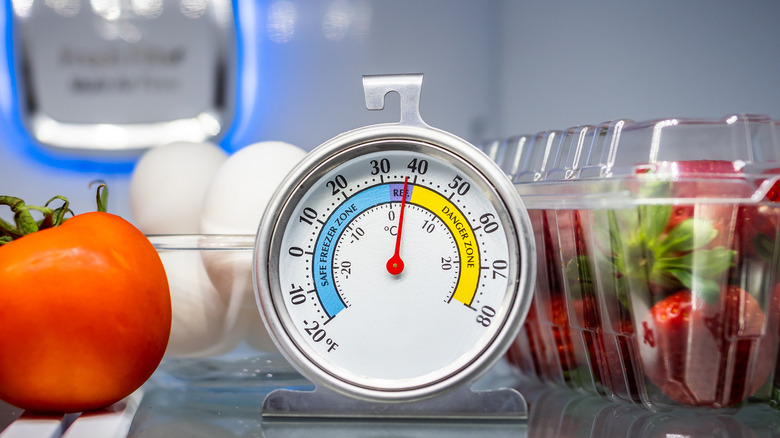What's The Perfect Temperature To Set Your Refrigerator?
Of all the workhorses of the kitchen, we'd like to take a moment to send some love to our refrigerator. With the rare exceptions of when we need to buy a new one or when there's a power outage, many of us are guilty of putting little thought toward this incredible technological advance in keeping food fresh and safe to eat. Developed for commercial use in the 1850s, refrigeration, as Apartment Therapy explains, didn't really take off for home use until 1927, when General Electric introduced its "monitor top" refrigerator, which beguiled well-off customers: The GE refrigerator cost $525, which in today's dollars comes to around $8,250, according to Saving.org.
Over time, and with more advancements in technology, home refrigerators became more and more common, eventually completely replacing the previous ice box systems (via History). Today, nearly 100% of American homes have a fridge — and 23% of them have two or more, according to CNN. With all that refrigerator experience, you'd think that we'd know exactly how to use these things — but many of us remain confused about what temperature to set our refrigerators to.
40 degrees (or below) is the magic number
In order to keep foods fresh and safe to eat, the Food and Drug Administration (FDA) recommends setting your refrigerator to 40 degrees Fahrenheit, or even below — Real Simple says that between 35 and 38 degrees is ideal for keeping food very cold without going so far as to freeze it. As explained by U.S. News & World Report, microorganisms such as salmonella, E. coli, and listeria — which can cause an upset stomach or more severe illness — can't survive at these temperatures. On the other hand, the range between 40 and 140 degrees is known as the "Danger Zone," in which bacteria can grow very quickly and even double their numbers in 20 minutes.
So how to adjust your refrigerator's temperature? Most of us have spotted the fridge's temperature control dial, which tends to range from 1 (coldest) to 5 (warmest). Unfortunately, these levels don't let you set an exact temperature. Real Simple suggests purchasing a cheap appliance thermometer, placing it in the fridge for 20 minutes, and then checking the reading. You can do this and then fine-tune the dial a few times to get as close to that 38-degree temperature setting as possible.
Now that you have set your refrigerator's temperature, don't forget to make use of this essential home appliance: The FDA recommends refrigerating perishable foods within two hours. Follow these steps, and you'll have the most perfectly refrigerated foods on the block.

